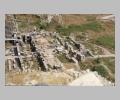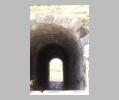| Context: | Miletus |
| Type: | Theater |
| Summary: | Theater with horseshoe-shaped cavea, and stage-building of many different periods; built into a hill between the Bay of Lions and the Theater Harbor. |
| Date: | ca. 300 BC - ca. 133 BC |
| Dimensions: | Dimensions of the first stage building: width 15.71 m., depth 7.28 m., height of lower story ca. 3.13 m., height of upper story 3.10 m., width of doors in lower story ca. 1.20 m. Dimensions of the second Hellenistic stage building: width 28.18 m., width of proscenium 31.51 m. (thus, wider than the stage building behind it). Dimensions of the third Hellenistic stage building: width 31.51 m., width of new central door of lower story 0.83 m., width of central door of upper story 4.19 m, width of pilasters between the thyromata in the upper story 1.70 m., height of upper story ca. 4.86 m. Dimensions of fourth Hellenistic stage building: width 39.90 m., dimensions of thyromata of upper story: central door 4.25 m., second pair 4.10 m., third exterior pair 4.01 m. |
| Region: | Ionia |
| Period: | Hellenistic/Roman |
Architectural Order:
Doric. The half-columns of the facade of the proscenium of phases one, two, three and four are reconstructed as Doric.
Plan:
The cavea of the theater originally consisted of three tiers each containing twenty rows of seats; the lowest tier is divided into five cunei or wedges by stairs, the second tier into ten wedges, and the upper tier had twenty wedges. This uppermost tier was destroyed with the construction of a mediaeval citadel in this location. The stage building underwent numerous transformations from the fourth century B.C. to the late third century A.D.; a significant feature of the plan of the theater is the incorporation of the rear wall of the stage building into the circuit of the city walls.
Date Description:
The evidence for the dating of the phases of construction is based on an examination of the masonry techniques, beginning with the earliest phase and its relationship to the city wall. Thereafter, subsequent construction phases are recognized on the basis of new foundations, changes in masonry technique, and new architectural elements. The date of the construction of the second stage building just a few decades after the first stage building is based on the observation that the wall construction is very similar, with the anathyrosis of the blocks being somewhat wider, and on the observation that this type of skene was typical for the third century B.C. There is no firm evidence for the date of the third skene beyond the observation that its architectural form is consistent with other stage buildings of the mid-second century B.C. A building inscription from the fourth skene provides a terminus post quem of the mid-second century, and the excavators postulate that this final Hellenistic stage building must date sometime prior to 133 B.C.
Analogies with buildings and construction techniques at other Asia Minor sites also provide some evidence for dating; for example, masonry courses in the west parodos wall are reminiscent of work of the Seleucid period at the Didymaion. The date of the construction of the thyromata of the third stage building is arrived at via analogy with similar developments at the
History:
The stage building and the cavea of the theater underwent significant transformations over time. Although the preserved remains date to the Roman period, the Hellenistic phases of construction are understood. Four phases of construction of the Hellenistic stage building have been recognized. The earliest skene, dating to ca. 300 B.C., was built along the line of the city wall. This skene may have had an upper story or episcenium, but had no central door in its lower story, only two flanking doors. There is no archaeological evidence for a proscenium for this first stage building, but the excavators propose a proscenium articulated with Doric half-columns and pilasters, via analogy with the proscenium of the
Shortly after the construction of the first stage building (ca. 300-250 B.C.) alterations were carried out, resulting in a much longer skene. During this period, there were four doors in the lower story and three in the upper story. The proscenium at this phase is reconstructed as being wider than the stage building, and having a facade articulated by 16 columns, although this is hypothetical.
The third phase of construction, dated by the excavators to sometime before the mid-second century B.C., resulted in significant changes to the stage building: a central door was opened in the lower story, the entire skene was widened again through the addition of wings at left and right, and the facade of the upper story was opened up with the addition of wide doors or thyromata. This change was probably prompted by the alteration in dramatic action which occurred at this time; the
The final Hellenistic stage building was probably necessitated by the need to provide an adequate logeion. Again, the entire stage building was widened. Only the central doorway of the lower story was left open; the others were filled in, making the chambers of the lower story inaccessible and emphasizing their function now as only the substruction for the more important upper story. Stone steps which led up to the logeion, and which were originally thought to belong to the fourth construction phase, are now known to date to the Roman period.
The basic outline of the seats in the lower tiers of the cavea is thought to date to the Hellenistic period, although little is preserved of the Hellenistic cavea. In the Flavian period and again in the late second century A.D. the stage building was further elaborated.
Other Notes:
The theater in its Roman phase represented one of the largest in Asia Minor, with a seating capacity for ca. 15,000 people.
Sculptural decoration from the Hellenistic theater, possibly from the second skene, includes relief blocks carved with Macedonian shields and other weapons. A frieze depicting hunting erotes is ascribed to the School of Aphrodisias, and is dated to the third century A.D.
Other Bibliography:
See Also:





